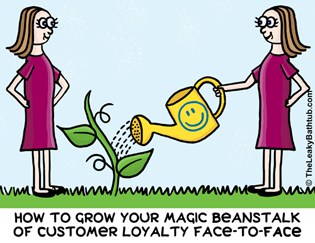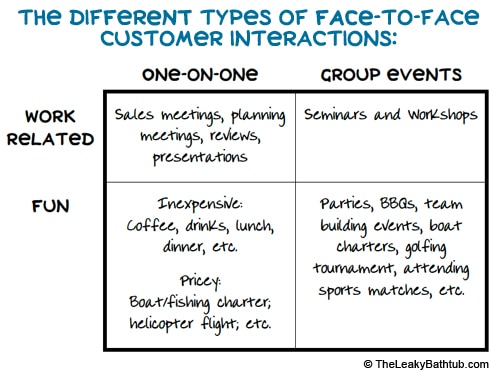
There are so many awesome technologies for staying in touch these days. And I use just about all of them to keep in touch with my dad… he lives in England, on the other side of the world to me.
We email each other most days; send SMS (text messages) for news we want to share right away; we talk on the phone; sometimes we Skype; and we send cards in the mail.
Sure, it’s great to have all this… but there’s nothing like seeing each other in person. Being able to take trips together, laugh together, hug. There’s nothing like seeing each other face-to-face, and when it’s been a while since we’ve had that connection, we really start craving it.
The connection with your customers isn’t quite as strong as this family bond, but the same rules apply.
Customers value face-to-face contact as well
Though you may not hug your customers, they will value face-to-face interactions from time to time!
This may depend on your industry to some extent… but even if you have an ecommerce website, and minimal customer interaction, it doesn’t mean you should rule this out completely.
Personal interactions move the business relationship from being a transaction to being, well, a relationship…
Transactions are cold, clinical, impersonal. If you merely transact business, your product or service becomes a commodity, and customers are quickly lured away to cheaper competitors. (Read: How to get your Customers to Climb the Magic Beanstalk of Customer Loyalty.)
But if you take the business relationship to a more personal level, customers become emotionally invested in it. The deeper the connection, the less likely that customers will be lured to a competitor. It’s up to you to deepen that connection, and face-to-face interactions are the way to do it.
What kinds of face-to-face interactions for customer retention are there?
There are 4 broad types of face-to-face interactions for customer retention:

Which type(s) of customer interaction should you choose?
The kinds of customer interactions you select depend on your business or industry. For example, group events generally work well for B2C (business-to-consumer) companies. Whether they work for B2B (business-to-business) organisations depends on the extent of the rivalry between the customers. I’ve worked in some industries, where customers are bitter rivals, and putting them in the same room together would be a seriously bad idea.
But in other industries, the competition between customers is friendlier – or non-existent even. So it’s up to you to decide what’s relevant for the business you’re in.
Another consideration is your budget
The amount that you spend on face-to-face interactions depends on the profitability of your customers. You need to keep that aligned with your expenses.
In practical terms, it can mean tiering your customers into different levels: it’s perfectly OK to take just your top 5% or 20% (or however many) of your customers out for lunch.
But what if you don’t want to have lunch with a customer?
If the thought of having lunch with a customer makes you cringe, then it may be best not to do it. Assess each case individually.
After all, not all customers are the same, and not everyone likes being taken out to lunch.
The whole purpose of this exercise is to interact in a way that’ll deepen the relationship, and for that to happen the other party has to enjoy the experience! So if you think that lunch together would be a big flop, then don’t do it.
Again, it’s up to you to make the call as to what’s suitable – and what simply won’t work.
If socialising is a no-no, then focus on work-related catch-ups. That’s fine. The important thing is that you do schedule them!
Schedule year-round customer interactions
Imagine if I didn’t phone or email my dad for 3 months. He’d be pretty upset, right? Good relationships need regular contact, and the same applies with your customers.
So make sure that you schedule regular catch-ups with your customers throughout the year. Diarise reminders. Do what you need to do to make them happen.
And again, it’s fine to tier customers into different levels: it’s not practical or helpful to visit every customer every week. After all, not all customers are created equal; they don’t all spend the same amount with you.
For example, in one company where I worked, the Business Development Managers in the sales team had different schedules for different customers. The A-Grade customers would get a visit every month, and phone calls in-between times at least once a week. (These customers needed a lot of servicing.) The B-Grade customers may receive a visit every quarter, and phone calls every two weeks. And the C-Grade customers would get one visit a year, and a monthly phone call… that’s all that was needed (or was relevant) to the smaller customers. What you do depends on your customers, and also the resources you have available to you.
What about industries where face-to-face interactions are tricky?
If seeing customers one-on-one isn’t possible, try to organise a seminar or workshop once or twice a year… if it’s appropriate to your business, of course.
Or if you really can’t manage that, at least fill in the gaps with other media: after all, you have snail mail, email, social media, Skype/instant messaging, the telephone and SMS (text messaging) available to you… make the most of it!
After all, while my dad understands that I can’t visit him as often as I’d like, I at least make up for that in other ways! And you should do the same with your customers. Whereas family bonds are hard to break, customer bonds are far more fragile and you need to treat them as such.
Summary
- Face-to-face interactions deepen business relationships, which can help with your customer retention.
- There are 4 different types of face-to-face interactions you can have with your customers: they can be work-related, fun, one-on-one or group events.
- The nature of the interactions will depend on your industry, budget and resources… as well as what your customer will enjoy.
- Ideally, you should schedule face-to-face interactions all year round, though it can be worth tiering your customers so that the attention they receive is in line with their spend.
- If you really can’t spend time face-to-face with your customers, make the most of all the other media you have available to you: snail mail, email, social media, Skype/instant messaging, the telephone and SMS (text messaging).



